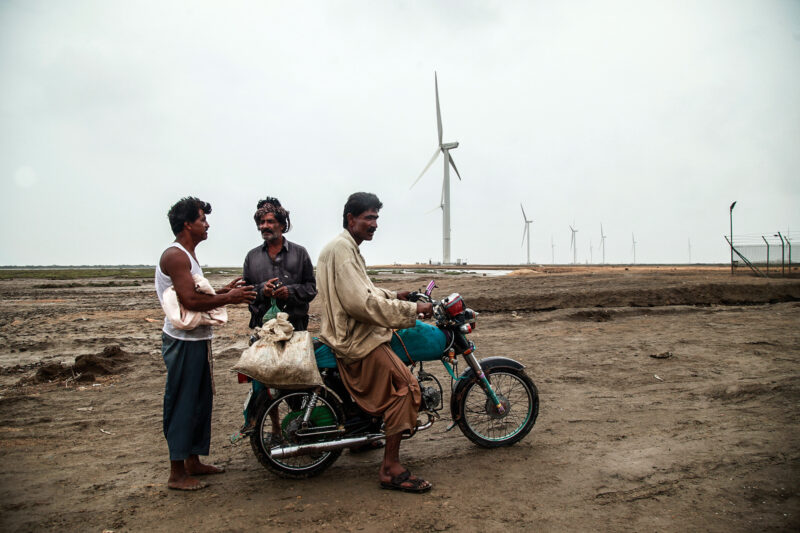Renewed hope for tackling climate change - could it boost South Asia cooperation?
Fahad Saeed, Ursula Fuentes-Hutfilter
Share

Following the recent net zero announcements from big emitters, and as the newly elected US president Biden sets to work enacting his ambitious national and international climate agenda, it is high time that South Asia uses the current global wave of optimism in the fight against climate change to boost regional cooperation.
Imagine the plight of a person affected by a climate disaster: their land inundated, home destroyed, livestock lost, family vulnerable to food shortages, life-threatening diseases and environmental risks. They are victims of climate change; something they have done very little to cause.
This can be the story of an average person in South Asia, home to some of the most vulnerable countries to climate change risks, which incur enormous economic losses each time disaster strikes. Communities in these countries often face a life-long struggle to regain their pre-disaster level of wealth.
Unfortunately, due to various socio-economic challenges and the region’s geo-political situation, the issue of climate change generally takes a back seat. However, considering the level of threat the region faces from climate change, South Asian countries should be the ones most concerned about how the world’s governments are progressing in achieving the goals of the Paris Agreement.
Tracking climate action at the global level
While 2020 has been a depressing year for the whole world amid the COVID-19 crisis, the year ended on a positive note in terms of progress on climate action, amid recent announcements by some of the largest emitters, including China, the USA, South Africa, Japan, South Korea and Canada, to cut their emissions to zero by around 2050-2060.
Recent analysis carried out by the Climate Action Tracker showed that if all the governments that pledged mid-century net zero targets – together they are responsible for 63% of global greenhouse gas emissions – deliver on their promises, global warming could be as low as 2.1°C. This would keep the Paris Agreement’s goal of limiting global warming to 1.5°C remains within reach.
Moreover, real-world action temperature estimate based on all adopted national policies to date has also indicated a marked reduction with a decrease of 0.7°C from 3.6°C in 2015 to 2.9°C today.
This optimism is attributed largely to new plans from the world’s two biggest emitters, China and the US, who together played a defining role in the success of Paris Agreement back in 2015. This time, China’s announcement to achieve carbon neutrality before 2060, as well as President Joe Biden’s promise to achieve net zero emissions by 2050, has revived the hopes once again. This follows the EU’s lead in adopting a net zero greenhouse gas emissions goal for 2050 back in 2019. The 2050-2060 period is crucial as it aligns with the findings of IPCC special report on 1.5°C (SR1.5), which finds that global CO2 emissions must reach zero by 2050 and other GHG by 2070, to stand a good chance of limiting warming to 1.5°C.
Eliminating CO2 and other GHG emissions before these dates would have the benefit of halting warming earlier and would significantly reduce the 21st century requirement for carbon dioxide uptake by forests and soils and carbon removal using technological means.
While setting net zero targets is an important step, the effectiveness of these long-term goals depends critically on the near-term actions. Another crucial benchmark for the Paris Agreement 1.5°C temperature goal identified in the IPCC’s 1.5°C report is cutting emissions by at least 45% from 2010 level. A recent study concludes that we would see the result of near-term rapid emission cuts, in line with the Paris Agreement 1.5°C limit, within the next two decades: the risk of experiencing unprecedented warming rates would be 13 times lower, compared with continued heavy reliance on fossil fuels.
This calls for stringent climate action to steeply reduce emissions in the next ten years, and underscores the importance of ramping up the ambition level of governments’ Paris Agreement carbon cutting pledges (known as Nationally Determined Contributions or NDCs). Not many countries have done so and only a few NDCs submitted in 2020 are compatible with the 1.5 ̊C temperature goal and in line with moving to net zero by 2050. It remains to be seen whether the ambitions expressed by countries so far will translate into concrete transformational steps in the near future.
South Asia and the Paris Agreement temperature goal
South Asia hosts approximately a quarter of world’s population with a high incidence of poverty. To eradicate poverty, how the rapidly growing economies of South Asia choose to meet increasing energy demand will have major implications for global efforts to tackle climate change. India is by far the largest economy of the South Asia region, one of the largest CO2 emitters in the world, and therefore has a crucial role to play in global climate action.
South Asia has vast renewable energy potential and utilisation of solar and wind only could satisfy the growing electricity needs of almost all the countries in the regions many times over. Moreover, an energy system transformation towards renewables would have multiple benefits for sustainable development through increased energy security and access to modern energy for all, avoided air pollution damages and reduced or avoided water use, land contamination and environmental degradation.
To achieve goals of Paris Agreement and sustainable development, South Asian countries need to decarbonise their energy systems by 2050, mainly through a rapid increase in of renewable energy use, and decarbonisation of end use sectors through electrification or direct use of renewable energy, as well as large demand reductions across all end-use sectors. Most importantly, the countries need to urgently consider how to reverse their current trend of expanding coal-fired generation capacity in order to limit the risk of stranded fuel assets as well as meeting Paris Agreement goals. To enable this, they would need to develop plans to phase out use of coal for power generation by 2040, while accelerating renewable energy take-up to reach at least 50% electricity generation share by 2030. A well-managed transition would come with many benefits such as reduced air pollution, increased energy security, access to clean and affordable energy for all, as well as sustainable regional employment opportunities.
The way forward
Due to the transboundary nature of the effects of climate change, cooperation and collaboration between South Asian countries become even more critical as do concerted efforts in building institutional capacity, research and dissemination of outcomes, and exchanging knowledge and best practice.
In 2008, the Expert Group of South Asian Association for Regional Cooperation (SAARC), the regional intergovernmental organisation and geopolitical union of states, identified seven areas needing attention: adaptation to climate change; policies and actions for climate change mitigation; policies and actions for technology transfer; finance and investment; education and awareness; management of impacts and risks; and capacity building for international negotiations. The political, geographic and economic landscape of South Asia makes it challenging. Despite efforts by SAARC, relationships among most South Asian governments have not progressed to a stage where mutual trust and interest is evident.
The science has become clearer in pinning down the high level of risks all countries of the region are facing at the current level of warming of 1°C since pre-industrial. To ride the current wave of high optimism at the global level to fight climate change, it is high time to make concerted efforts in building mutual trust among South Asian countries by initiating regional cooperation in letter and spirit. Revival of SAARC can provide a much-needed platform to achieve this. Because, in the words of former UN Secretary General Ban Ki-moon, “climate change knows no national borders.”
Header image: Fishermen return from their day of fishing in Pakistan's Thatta District, Sindh province. Construction of the roads as part of the wind energy project has made the sea more accessible for them to fish and make a better living. Asian Development Bank, Flickr (CC BY-NC-ND 2.0 DEED)












